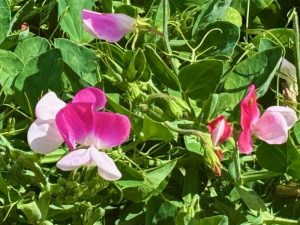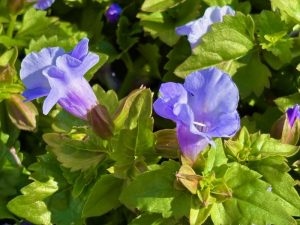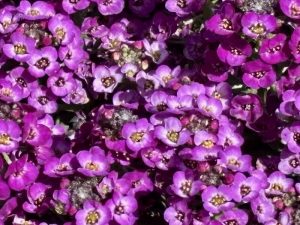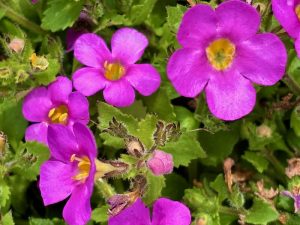Lathyrus odoratus ‘Pink Cupid’: The Delightful Dwarf Sweet Pea for Fragrant Gardens
Lathyrus odoratus ‘Pink Cupid’, commonly known as Sweet Pea ‘Pink Cupid’, is a charming and compact variety of sweet pea that fills gardens with fragrant, delicate pink flowers. This dwarf cultivar stands out for its sweet scent and bushy growth habit, making it an excellent choice for small gardens, containers, and window boxes. Belonging to the Fabaceae family, sweet peas are annual climbing plants native to Sicily, southern Italy, and the Aegean Islands. They have been cultivated for centuries and cherished for their vibrant colors and captivating aroma.
Sweet Pea ‘Pink Cupid’ produces clusters of rose-pink and white flowers from late spring through summer. Unlike taller sweet pea varieties that require extensive support, this cultivar grows to about 6 to 12 inches (15 to 30 cm) tall with a spread of approximately 12 inches (30 cm). Its compact size, combined with its enchanting fragrance, makes it a garden favorite for those seeking a sweet-smelling flower in smaller spaces.
Description of Lathyrus odoratus ‘Pink Cupid’ Flowers and Foliage
The delicate flowers of Lathyrus odoratus ‘Pink Cupid’ appear in showy racemes, displaying soft rose-pink petals tinged with white. Each flower spans roughly 1 to 3 inches (2.5 to 7.5 cm) across and carries the classic pea-like shape with irregular, lipped petals that sweet peas are known for. These blooms offer a strong, sweet fragrance that perfumes the air around them, attracting pollinators and delighting gardeners alike.
The foliage features pinnately compound leaves with one to three pairs of medium to dark green leaflets. Each stem ends in a tendril, which in taller sweet pea varieties helps the plant climb. While ‘Pink Cupid’ often grows as a bushy mound, it can also climb if given light support. The lush, green leaves provide a lovely backdrop to the soft pastel flowers.
Habitat and Growing Conditions
Sweet peas thrive best in cool, temperate climates with full sun exposure. They need at least six hours of direct sunlight daily to bloom well. In hotter climates, providing afternoon shade protects the plants from excessive heat and prolongs flowering. The ideal planting site offers good air circulation and fertile, well-drained soil.
This variety prefers moist but well-draining soil enriched with organic matter. Sweet peas like a slightly alkaline soil pH between 6.5 and 7.5. Heavy clay soils benefit from added compost or well-rotted manure to improve texture and drainage, while sandy soils should be enriched to hold moisture and nutrients. Lathyrus odoratus ‘Pink Cupid’ adapts well across USDA Hardiness Zones 2a through 11b, making it suitable for many regions.
How to Grow Lathyrus odoratus ‘Pink Cupid’
Light: Place your Sweet Pea ‘Pink Cupid’ in a spot that receives full sun, aiming for at least six hours of direct sunlight each day. In areas with intense summer heat, choose a site that offers some afternoon shade to reduce stress on the plant.
Soil: Prepare moist, humus-rich soil that drains well. If your garden soil is heavy clay, mix in plenty of organic compost to improve drainage. For sandy soils, add organic matter to retain moisture and nutrients. Before planting, check that the soil pH is slightly alkaline, ideally between 6.5 and 7.5.
Watering: Keep the soil consistently moist but avoid waterlogging. Water deeply and regularly during dry periods, especially when buds begin to form. Morning watering helps reduce fungal risks by allowing foliage to dry during the day.
Fertilizing: Incorporate compost or bone meal into the planting soil to supply nutrients. During the growing season, feed every two weeks with a fertilizer low in nitrogen but rich in phosphorus and potassium. This balance promotes flower production rather than excessive leaf growth.
Support: Though ‘Pink Cupid’ is compact and often grows bushy, providing light support such as small stakes or a low trellis encourages upright growth and improves air circulation, reducing disease risk.
Pruning and Deadheading: When seedlings reach 4 inches (10 cm), pinch off the growing tips to stimulate branching and produce more flowering stems. Regularly remove faded flowers (deadhead) to encourage continuous blooming and prevent seed formation, which can shorten the flowering period.
Propagation of Lathyrus odoratus ‘Pink Cupid’
Propagate this variety by seed for the best results. Before sowing, nick or lightly sand the seed coats and soak seeds in warm water for 24 hours to improve germination. Sow seeds about 1 inch (2.5 cm) deep and space them 2 to 3 inches (5 to 7.5 cm) apart. Start seeds indoors 6 to 8 weeks before the last frost in cold climates, then transplant outside once the soil warms. In milder regions, sow seeds outdoors in late fall or early spring for early blooms.
Pest and Disease Management
While sweet peas have good disease resistance, they are vulnerable to common garden pests and fungal issues. Aphids, powdery mildew, slugs, and snails can affect plant health and flower production. Regularly inspect your plants and treat aphids with insecticidal soap or blast them off with water. Prevent powdery mildew by ensuring plants have good air circulation and avoid overhead watering. Use slug traps or organic barriers to protect seedlings and mature plants from slug and snail damage.
Environmental Tolerances and Special Considerations
Sweet Pea ‘Pink Cupid’ prefers cooler growing conditions and will struggle in extreme heat or humidity. In hot climates, morning sun and afternoon shade help prolong the blooming period. Remember that all parts of sweet peas, especially seeds, are toxic to humans and pets if ingested. Keep plants out of reach from children and animals.
Harvest flowers in the early morning when blooms are fresh and fully formed for the longest vase life. These fragrant blossoms are excellent for cut flower arrangements and add an inviting aroma to any room.
Uses and Garden Design Ideas for Sweet Pea ‘Pink Cupid’
Sweet Pea ‘Pink Cupid’ fits beautifully in small spaces due to its dwarf habit. Use it in containers, window boxes, hanging baskets, and garden borders. It suits cottage gardens and mixed containers where its fragrance can be appreciated up close. Plant near patios, doors, or walkways to enjoy the scent daily.
Pair it with plants such as lavender, salvia, or daisies to create a classic summer garden palette. Its soft pink and white flowers contrast beautifully with blue and purple blooms, bringing harmony and interest to your garden design.
Lathyrus odoratus ‘Pink Cupid’ offers gardeners an enchanting, fragrant flower in a compact form. Plant it in fertile, well-drained soil under full sun or partial shade, water consistently, and fertilize properly to enjoy a summer of delightful blooms. With proper care and attention, this dwarf sweet pea will reward you with fragrance, color, and charm that brighten any garden or container space.






